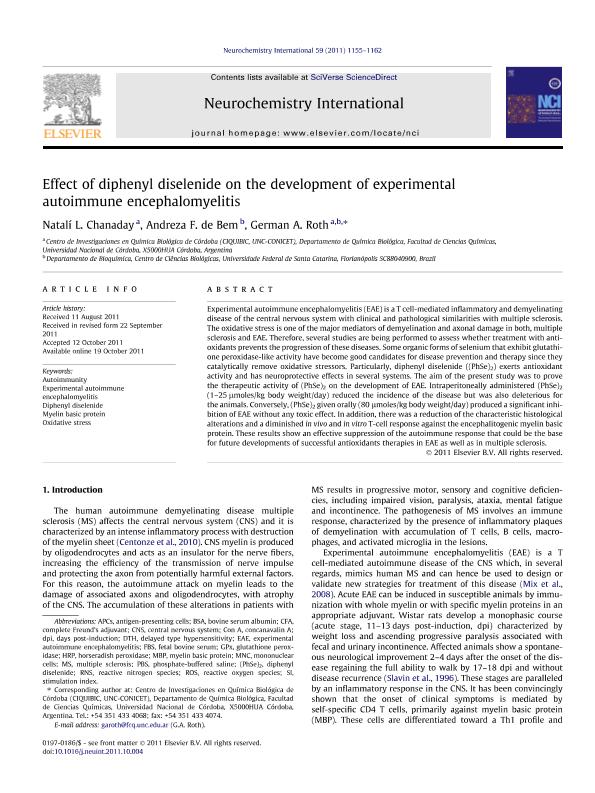Artículo
Effect of diphenyl diselenide on the development of experimental autoimmune encephalomyelitis
Fecha de publicación:
10/2011
Editorial:
Pergamon-Elsevier Science Ltd
Revista:
Neurochemistry International
ISSN:
0197-0186
e-ISSN:
1872-9754
Idioma:
Inglés
Tipo de recurso:
Artículo publicado
Clasificación temática:
Resumen
Experimental autoimmune encephalomyelitis (EAE) is a T cell-mediated inflammatory and demyelinating disease of the central nervous system with clinical and pathological similarities with multiple sclerosis. The oxidative stress is one of the major mediators of demyelination and axonal damage in both, multiple sclerosis and EAE. Therefore, several studies are being performed to assess whether treatment with antioxidants prevents the progression of these diseases. Some organic forms of selenium that exhibit glutathione peroxidase-like activity have become good candidates for disease prevention and therapy since they catalytically remove oxidative stressors. Particularly, diphenyl diselenide ((PhSe)2) exerts antioxidant activity and has neuroprotective effects in several systems. The aim of the present study was to prove the therapeutic activity of (PhSe)2 on the development of EAE. Intraperitoneally administered (PhSe)2 (1–25 lmoles/kg body weight/day) reduced the incidence of the disease but was also deleterious for the animals. Conversely, (PhSe)2 given orally (80 lmoles/kg body weight/day) produced a significant inhibition of EAE without any toxic effect. In addition, there was a reduction of the characteristic histological alterations and a diminished in vivo and in vitro T-cell response against the encephalitogenic myelin basic protein. These results show an effective suppression of the autoimmune response that could be the base for future developments of successful antioxidants therapies in EAE as well as in multiple sclerosis.
Palabras clave:
Diselenide
,
Encephalomyelitis
,
Myelin
,
Glutamate
Archivos asociados
Licencia
Identificadores
Colecciones
Articulos(CIQUIBIC)
Articulos de CENTRO DE INVEST.EN QCA.BIOL.DE CORDOBA (P)
Articulos de CENTRO DE INVEST.EN QCA.BIOL.DE CORDOBA (P)
Citación
Chanaday Ricagni, Natalí Luján; Andreza, Fabro de Bem; Roth, German Alfredo; Effect of diphenyl diselenide on the development of experimental autoimmune encephalomyelitis; Pergamon-Elsevier Science Ltd; Neurochemistry International; 59; 8; 10-2011; 1155-1162
Compartir
Altmétricas




